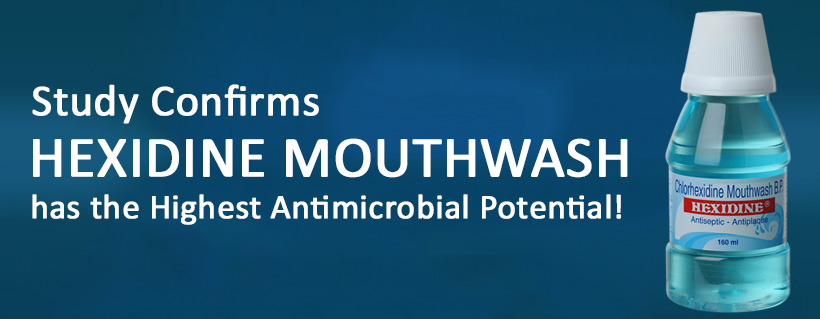Menu

Date: 2nd. May,2017
Despite the advances in medical technology, dental caries remains one of the most prevalent diseases around the world. Dental caries is caused due to damage to the outer tooth structure. The acids released as by-products of carbohydrate metabolism by the microbes, weaken the enamel and result in caries.
To improve oral hygiene, the use of mouthwashes has increased is on the rise. In a study published in the Jundishapur Journal of Microbiology, Hexidine Mouthwash was found to be the most effective mouthwash against caries causing microbes.
This study was authored by Kamal Rai Aneja, Radhika Joshi, and Chetan Sharma from Department of Microbiology, Kurukshetra University. The aim of this study was to test the efficacy of ten of the most commonly available mouthwashes. The four pathogens these mouthwashes were tested against were:
For the study, the following mouthwashes were obtained from drug stores:
| Name | Manufacturer | Ingredients as listed on packages |
| Hexidine | ICPA Health Products Ltd. | Chlorhexidine gluconate 0.2%w/v in pleasantly flavored aqueous base |
| Listerine (Cool Mint) | Pfizer Ltd. | Thymol 0.06%, Eucalyptol 0.09%, Menthol 0.04%, Ethanol 21.6%v/v. |
| Chlorhexidine | Blue Cross Laboratories Ltd. | Chlorhexidine gluconate 0.2%w/v in pleasantly flavored aqueous base |
| Toss-K | Ind-Swift Ltd. | Potassium nitrate 3%w/v, sodium fluoride 0.2%w/v in pleasantly flavored aqueous base |
| Zytee | Raptakos, Brett and Co. Ltd. | Clove oil 1%, Mentha oil 1%, Menthol 1%, Chamomile oil 0.015%, Sodium benzoate 2%, Ethanol 31%v/v |
| Hexnor | Dynor Pharmaceuticals Pvt. Ltd. | Chlorhexidine gluconate 0.2%w/v, Sodium fluoride0.05%w/v, Zinc chloride 0.09%w/v |
| Senquel-AD | Dr. Reddy’s Laboratories Ltd. | Potassium nitrate 3%w/v, Sodium fluoride 0.2%w/v in pleasantly flavored aqueous base |
| Chlohex | Dr. Reddy’s Laboratories Ltd. | Chlorhexidine gluconate 0.2%w/v in pleasantly flavored aqueous base |
| Chlohex plus | Dr. Reddy’s Laboratories Ltd. | Chlorhexidine gluconate 0.2% w/v, Sodium fluoride 0.05%w/v, Zinc vhloride 0.09%w/v in pleasantly flavored aqueous base |
| Triguard | FDC Ltd. | Chlorhexidine gluconate 0.2%, Sodium fluoride 0.05%, Zinc chloride 0.09% in pleasantly flavored base |
To evaluate the antimicrobial potential of the mouthwashes, the following two techniques were employed:
In this technique, a one-percent nutrient broth was prepared containing 10% concentration of mouthwashes. Once the broth and mouthwashes were autoclaved, they were inoculated with 100µl of microbial inoculums, which were adjusted to 106cfu/ml. The inoculums were aerobically incubated at 37°C for 24 hours.
To check the microbial growth, the inoculated broths were suspended and optical density was measured at 490nm using a spectrophotometer. These experiments were performed in sets of three for each mouthwash and the mean for all four microbes was calculated.
In this method, using sterile distilled water for dilution, different mouthwashes were tested at four concentrations:
On the recommended media for each microbe, a pure isolate was subcultured for 24 hours at 37oC. At least four colonies of microbes were touched with a sterile loop and transferred to a saline (0.85%) tube. Then, the density of each suspension was set to 106 cfu/ml (standardized by 0.5McFarland standard), which was used as the inoculum.
100µl of mouthwash at all four concentrations was propelled directly into the wells for each microbe. After allowing the media agar plates to stand for 10 minutes for diffusion, they were incubated at 37oC for 24, 48, and 72 hours.
The experiments were performed in sets of three and the mean values of inhibition zones’ diameter with standard deviation were calculated.
Nutrient broth and sterile distilled water were used as negative control in technique one and two, respectively.
Hexidine Mouthwash by ICPA Health Products Ltd. delivered the best results, showing no turbidity at all. This indicates its effectiveness against caries causing microbes. Chlohex and Triguard also showed good results, however with slightly less effectiveness.
ConclusionZytee and Chlohex plus were found to be weaker still, while Hexnor, Chlorhexidine and Listerine only showed average results. Toss-K and Senquel-AD were completely ineffective against the microbes. Below are two graphs that show the action of mouthwashes on various microbes:

Mean diameter and standard deviation of zones of inhibition for ten mouthwashes after 24 hours at full strength against 4 caries causing microorganisms.

Microbial growth of S. mutans in nutrient broth with different mouthwash substitutes: summary of optical density data (three sets of experiments)
Out of the 10 mouthwashes used for the study, the 6 that proved to be the most effective against microbes contained chlorhexidine gluconate as their basic constituent. Hexidine Mouthwash (ICPA Health Products Ltd.) showed the excellent results against all four microbes.
To read the full study, click here.


| PRODUCTS | QTY | PRICE | VALUE in INR |
|---|
| PRODUCTS | QTY | PRICE | VALUE in INR |
|---|
3 thoughts on “Study Proves Hexidine is the Most Effective Caries Prevention Mouthwash”
Hi. Thx!
c2231c2074322.com